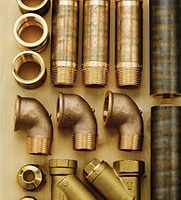Feedback that ICC is receiving about pipe joining

When industry veterans reminisce on the process of pipe joining, their stories often start with threading. Dry-fitting or dry-sealing a gas line. Tapered threading for metal and plastic pipes.
“Pipe joining used to require only highly-skilled tradesman to make consistently reliable connections,” said Fred Grable, senior staff engineer at the International Code Council (ICC).
Though older pipe joining methods, such as threading, have not necessarily been labeled extinct in the industry, there has been an evolution of joining methods. For pressurized fluids, the evolution of joining includes soldering/brazing/welding, flare/compression, grooved and shouldered connections, insert-with-ring crimping, solvent cementing, press-connecting, heat fusion, and most recently, push-fit connecting.
ICC codes have kept pace with all of the new methods. The International Codes (I-Codes) are model codes published by ICC and developed by ICC members to provide minimum safeguards. ICC uses the governmental consensus process to develop its codes. It is an open, inclusive process that allows input from all individuals and groups. Committees hear all code change proposals. Final decisions are made by ICC voting members — governmental and honorary members who, with no vested interests beyond public safety, represent the public’s best interest.
“ICC staff doesn’t make any of the decisions about what goes into the I-codes,” Grable explained. “Although ICC doesn’t have research programs, and doesn’t author the codes, we do support relevant industry research and provide numerous venues for people to come together in committees to develop ideas into viable solutions and improvements for proposal to the I-Codes. ICC facilitates the code change development process.”
Currently, there are four I-Codes that address piping and pipe joints requirements: International Mechanical Code, International Plumbing Code, International Residential Code, and International Fuel Gas Code.
One trend of pipe joining that ICC has noticed over the last five years is the press-connect method for metallic piping.
“Basically, the end of the pipe is cut off squarely, deburred, and inserted into a specialized fitting,” Grable said. “Then, using a specialized set of crimping jaws, the fitting is mechanically crimped onto the pipe. The fitting is permanently locked to the outside of the pipe with an internal o-ring sealing the joint.”
Grable recognized that there is a significant cost associated with the variety of crimping tools and powered mechanisms needed for all sizes of piping, over the thousands of joints made. However, he concluded that the cost is insignificant in light of the reduced labor and improved joint quality and reliability.
“The whole evolution of pipe joining is about trying to reduce the amount of time to put together piping systems while having few, if any, leaks that require rework. Sometimes this also reduces the level of tradesmen skill that is needed to do some of that work,” Grable said. “Contractors are eager to use newer joining methods that result in fewer leaks and less time per joint.”
Getting a new joining method approved on projects is not always easy. Grable explained that proponents of press-connect technology found it initially difficult to get the method accepted for various projects across the country. Eventually, the technology was accepted by some larger jurisdictions on a special approval basis.
Ultimately, with those successful experiences, acceptance of that method provided the confidence for the method to be approved by ICC voting members for inclusion into the I-Codes. Press-connect technology is one of the examples of newer technology that has been introduced to increase joint quality and less rework, and reduce the amount of time necessary to make joints.
Fusion joining for polyethylene plastic piping is another newer method that was recently put into the codes. Grable addressed both the skill and speed of this method.
“Basically, the ends of the plastic piping are heated to melt point and are then simply stuck together,” Grable quipped. “Although simple in concept, the method does require specialized heating equipment (platens), a fixture to accurately push the ends of the piping together, and operator training to use the equipment for all of the various pipe sizes. The method doesn’t require great skill, as most operators can be quickly trained to follow simple directions for the use of the joining equipment. The fusion method is relatively fast, especially for larger size piping. And the joints are of very high quality, typically as strong as the piping.”
The most recent method of piping joining is push-fit fittings. Both metal and plastic piping can be joined using this method. The technology further reduces the need for high-level trade skills and increases the speed of joint assembly. This helps to lower the overall cost per joint, while also maintaining excellent joint quality and reliability.
“The specialized push-fit fitting incorporates an internal o-ring for sealing. The pipe end is inserted into the fitting and an integral mechanical retaining mechanism prevents the pipe from being removed from the fitting. The installer simply pushes the pipe into the fitting and the joint is completed,” Grable explained. “There is no external tooling necessary and very little skill is needed to make those joints.”
Grable added, “Some push-fit fitting designs even allow removal of the pipe from the fitting using a special unlocking tool. Reworking a piping system or remodeling a building having these removal-type push-fittings will be very easy to accomplish.”
While inclusion in code is not the end-all-be-all that determines whether an installer will utilize a specific pipe joining method or whether an engineer will specify a certain pipe joining method for a project, it does validate that the method is acceptable for use according to a consensus-driven decision-making process.
“I have heard of increasing widespread use of press-connect fittings on commercial building projects. Push-fit fittings are also becoming increasingly popular for residential buildings, largely in single family dwellings,” Grable said. “These methods are still relatively new so an immediate conversion to these newer methods has not happened. However, as the use of these newer methods will undoubtedly grow in future year, having these newer methods in the codes will provide an easy path for plan approvals and inspections where an installer or engineer chooses to use these cutting-edge joining technologies.”





